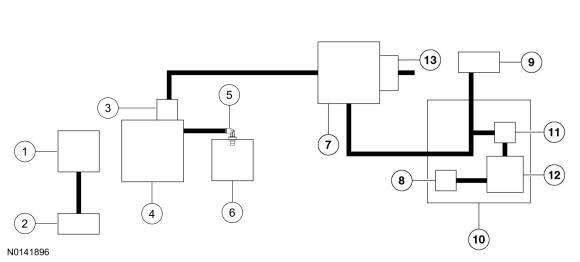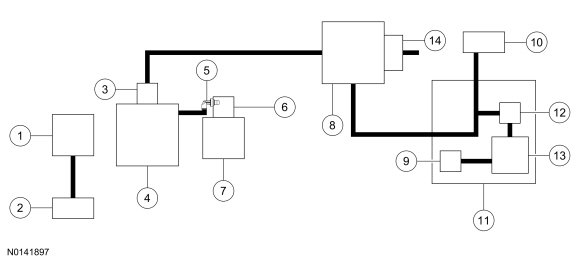SECTION 303-13: Evaporative Emissions
| 2014 Flex Workshop Manual
|
DESCRIPTION AND OPERATION
| Procedure revision date: 05/02/2013
|
Evaporative Emissions
The
system consists of the:
- canister purge valve.
- canister.
- dust separator and
canister vent solenoid assembly.
- fuel vapor tube assembly (includes the
sensor).
- Easy Fuel
TM
(capless) fuel tank filler pipe.
The
system:
- utilizes an
system that captures the fuel vapors from the vehicles fuel tank during refueling.
- prevents hydrocarbon emissions from reaching the atmosphere.
- stores fuel vapors in the
canister that are generated during vehicle operation or hot soak, until they can be consumed by the engine during normal engine operation.
- routes the stored fuel vapors to the engine during engine operation.
- is controlled by the PCM which, using various sensor inputs, calculates the desired amount of purge flow. The PCM regulates the purge flow, induced by the application of intake manifold vacuum, by varying the duty cycle applied to the
canister purge valve.
The fuel vapors are routed:
- from the fuel tank through the fuel vapor vent valve.
- to the
canisters through the fuel vapor tube assembly.
- to the engine when the
canister purge valve is opened by the PCM.
The
sensor:
- is part of the fuel vapor tube assembly.
- monitors the pressure levels in the fuel tank.
- communicates the pressure reading to the PCM during the
II leak test.
The fuel vapor tube assembly:
- is located on the top of the fuel tank.
- is used to control the flow of fuel vapors entering the
system.
The
canister:
- is located midship under the RH side of the vehicle.
- contains activated carbon.
- stores fuel vapors.
Easy Fuel
TM
(capless) fuel tank filler pipe:
- relieves system vacuum below -4.0 kPa (-16.05 in H
2
O).
The
canister vent solenoid:
- is normally open.
- seals the
system for the inspection and maintenance (I/M 240) test and
II leak and pressure tests.
- is serviced as part of the dust separator assembly.
The
canister purge valve:
- is normally closed.
- regulates the purging of the
canisters.
- is controlled by the PCM.
- is repaired as a separate item.
- is direct mounted to the intake manifold (3.5L
engine).
- is mounted to the intake manifold and is part of the vapor line (3.5L
engine).
The
dust separator:
- is attached to the
canister.
- prevents suspended dust and dirt particles from entering the
system.
- and the
canister vent solenoid are serviced together as an assembly.
The
system monitor:
- is a self-test strategy within the PCM which tests the integrity of the
system.
- monitors the
system for leaks.
- monitors electronic
components for irrationally high or low voltages.
- monitors for correct
system operation.
- uses negative and positive leak test methods to test and activate the
system.
For additional information on the operation of the
system monitor, refer to the Powertrain Control/Emissions Diagnosis (PC/ED) manual.
Vehicle Emission Vacuum Routing - 3.5L

| Item
| Part Number
| Description
| | 1
| 6582
| LH valve cover
|
| 2
| 9B659
| outlet pipe
|
| 3
| 9C915
| canister purge valve
|
| 4
| 9424
| Upper intake manifold
|
| 5
| 6A666
| PCV valve
|
| 6
| 6582
| RH valve cover
|
| 7
| 9E857
| canister
|
| 8
| —
| Fuel vapor vent valve (part of 9002)
|
| 9
| 9034
| Fuel tank filler pipe
|
| 10
| 9K007
| Fuel tank
|
| 11
| —
| sensor (part of 9C047)
|
| 12
| 9H307
| Fuel delivery module
|
| 13
| 9F945
| canister vent solenoid and dust separator assembly
|
Vehicle Emission Vacuum Routing - 3.5L

| Item
| Part Number
| Description
| | 1
| 6A505
| LH valve cover
|
| 2
| 9R530
| outlet tube
|
| 3
| 9G271
| canister purge valve and check valve assembly
|
| 4
| 9S455
| Upper intake manifold
|
| 5
| 6A666
| PCV valve
|
| 6
| 6A785
| Crankcase vent oil separator
|
| 7
| 6582
| RH valve cover
|
| 8
| 9E857
| canister
|
| 9
| —
| Fuel vapor vent valve (part of 9002)
|
| 10
| 9034
| Fuel tank filler pipe assembly
|
| 11
| 9002
| Fuel tank
|
| 12
| —
| sensor (part of 9C047)
|
| 13
| 9H307
| Fuel delivery module
|
| 14
| 9F945
| canister vent solenoid and dust separator assembly
|

